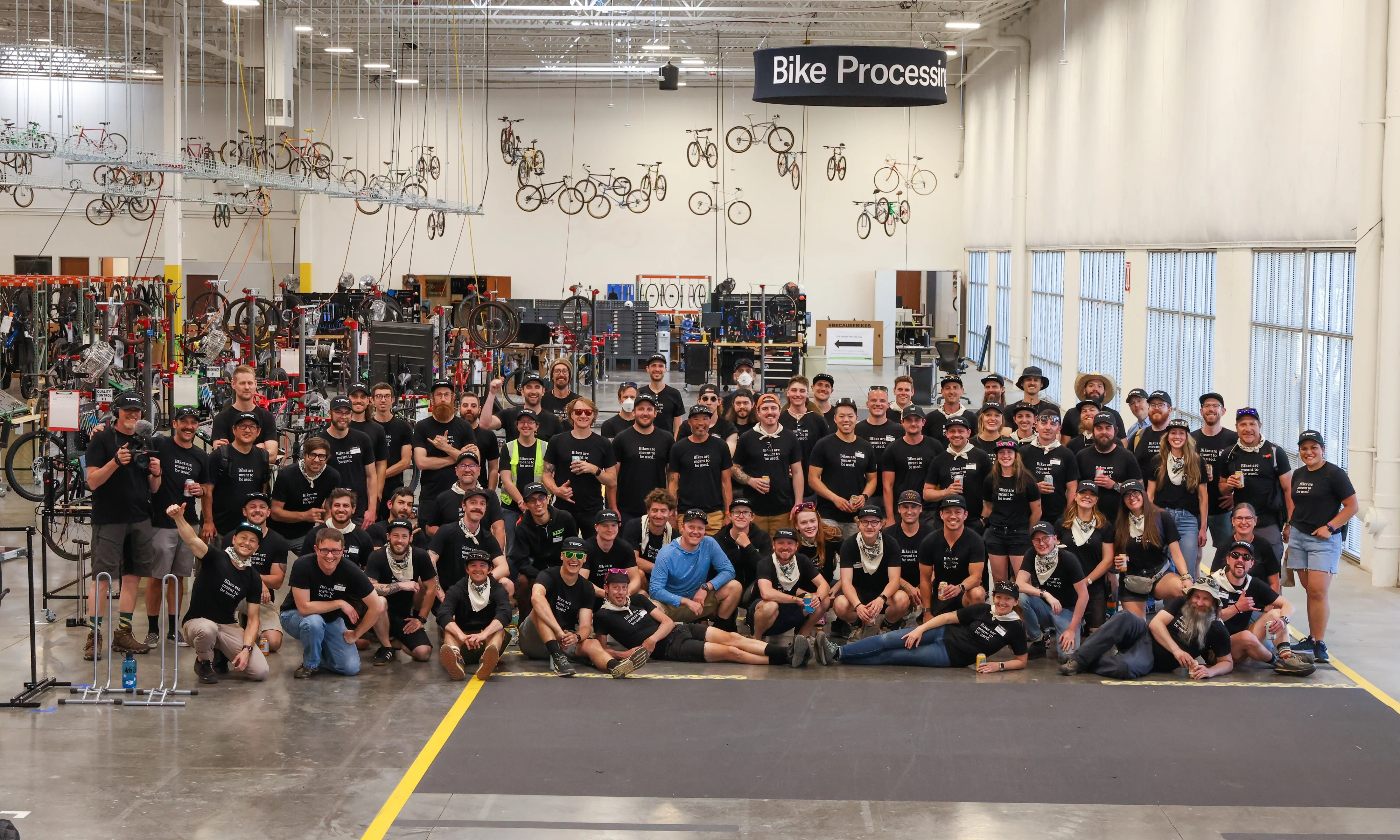I’ve always been one to choose a good set of wheels over a fancy frame and these days I’m partial to wheels from Zipp and ENVE. There’s not much on the market that could tempt me away. But if I had to ditch Zipp and ENVE, then the only worthy replacement is something with an even greater bling factor, right? Well, this might be it: the Wake 6560 Strada made by Princeton CarbonWorks.
These gold Princeton wheels are head turners, and the story behind their rise to prominence is one that gets gear nerds like me super hyped. I just had to bring them into the photo studio and drool all over them. I’ll explain why I want these wheels so badly, and why I’ll likely never own a pair.
[button]Shop Road Wheels[/button]
Big Rowers with Big Claims
 Princeton CarbonWorks comes out of Princeton, New Jersey, and more specifically, Princeton University. Its founders — Marty Crotty, along with Harrison Macris and Brad Werntz — mechanical and aerospace engineering graduates who were also collegiate rowers that had transitioned to cycling and triathlon.
Princeton CarbonWorks comes out of Princeton, New Jersey, and more specifically, Princeton University. Its founders — Marty Crotty, along with Harrison Macris and Brad Werntz — mechanical and aerospace engineering graduates who were also collegiate rowers that had transitioned to cycling and triathlon.
Elite rowers have big aerobic engines, so they tend to do well in cycling. They also tend to be on the larger end of the spectrum. Most are over 6 feet tall and over 200 pounds. Catering to big and powerful riders was a major part of Princeton CarbonWorks' wheel development goals. They wanted to build wheels that could stand up to massive watt-beasts (my words, not theirs) while maximizing weight and aerodynamics.
The Wake 6560 wheel was first conceived in 2012 and the first rideable models were completed in 2015. The name “Wake” paid homage to the founders’ backgrounds in competitive rowing. “6560” referred to the wheel’s defining feature: the sinusoidal — a.k.a. wavy — rim shape that alternates between 65mm and 60mm deep.
 This distinctive wavy shape is designed to provide extra strength. Carbon fiber is strongest when under tension, so each spoke is anchored to the top of a lobe so that they pull all the surrounding fibers taut and create even load across the rim. Princeton CarbonWorks claims the shape allows the rim to be made lighter than other carbon rims of similar depth without sacrificing durability. (The claimed rim weight is less than 490g.)
This distinctive wavy shape is designed to provide extra strength. Carbon fiber is strongest when under tension, so each spoke is anchored to the top of a lobe so that they pull all the surrounding fibers taut and create even load across the rim. Princeton CarbonWorks claims the shape allows the rim to be made lighter than other carbon rims of similar depth without sacrificing durability. (The claimed rim weight is less than 490g.)
Perhaps more important than the strength and weight advantages though, are the aero gains. They aren’t entirely a marketing gimmick, since wavy aero shapes had already been extensively studied by the US Navy and other researchers and used in other applications (like wind turbines).
Varying the leading edge of the rim with a wavy shape prevents stalls due to airflow separating from the surface. The airflow can stick to the rim through a far greater “angle of attack,” reducing drag and improving stability. Not only is it more efficient, but it also reduces the effect of crosswinds on deep-section wheels.

Zipp's Sawtooth design is similar.
In wind tunnel tests at the A2 Wind Tunnel in Mooresville, North Carolina, the Wake 6560 beat out favorites like the Zipp 404 and Hed Jet 6 Plus — it even beat the fancy Zipp 454 NSW which uses a similar wavy Sawtooth design. Zipp and SRAM clearly felt threatened, because they sued Princeton CarbonWorks (but lost), claiming that the Wake’s wavy shape was infringing on two of its patents.
The Ineos and MvdP Effect
 Photo: INEOS Grenadiers
Photo: INEOS Grenadiers
I was became aware of Princeton CarbonWorks back in 2018. James Huang had published a review of the Wake 6560 and said they were “wickedly fast in a straight line, and not in an overly subtle way.” I trust James’ opinions on gear more than anyone’s, but that wasn’t quite enough for me to start frothing over these wheels.
It was Team INEOS (formerly Team Sky) that made me finally take notice. By the 2020s, INEOS wasn’t the Grand Tour-destroying monster it once was, but it still had strong riders and plenty of obsessive tendencies. While I’m not necessarily a fan, I appreciated INEOS’ willingness to ditch sponsor-correct equipment in favor of gear they believed would give them an extra edge.
Shimano was one of the team’s main sponsors, but INEOS would often switch to non-Shimano wheels for key stages. In 2019, they would equip their bikes with Lightweight Meilenstein Obermayer wheels on the toughest climbing stages of the Tour de France. Then, in 2021, the wavy wheels from Princeton CarbonWorks became their secret weapon. For climbing stages, INEOS used the Princeton CarbonWorks Peak 4550, while the Wake 6560 front wheel and Blur 633 rear disc were used on time trial bikes.
 Ganna riding Princeton CarbonWorks to his first TT world championship in 2020. Photo: Bettini
Ganna riding Princeton CarbonWorks to his first TT world championship in 2020. Photo: Bettini
At the time, Filippo Ganna essentially looked unbeatable in a time trial, and while a lot of that comes from his massive engine, his riding position and gear were also extensively tested and perfected. He used Princeton CarbonWorks wheels to win back-to-back time trial world championships.
There was so much buzz behind these wheels, that when Dutch superstar, Mathieu van der Poel nabbed the Yellow Jersey in the 2021 Tour de France, his team used a credit card to buy a Wake 6560 and Blur 633 wheelset for van der Poel’s TT bike (though they only used the rear wheel) and had someone drive them 10 hours across the border from Andorra to give van der Poel enough of an edge to keep the Yellow Jersey.
With Ganna and van der Poel relying on these wheels for big results, it seemed like the world’s best were confirming that Princeton CarbonWorks made the fastest wheels.
 Photo: Princeton CarbonWorks
Photo: Princeton CarbonWorks
Back in late 2021, when the first set of Princeton CarbonWorks wheels arrived at TPC on a Pinarello Dogma F, a scrum of employees gathered around to check them out. The bold graphics and wavy design definitely made them stand out, and to be the coolest geek in a group ride, it was no longer enough to have some “basic” Zipps or ENVEs. You had to have a set of Princetons.
The Wake 6560 Strada: Not for Me, at Least Not Today
 I don’t have Princetons. I might not be cool enough to ride them. I’m definitely not rich enough! This Wake 6560 wheelset with Industry Nine hubs originally retailed for $3,000. Higher-end builds with different hubs or spokes could enter the $4,000 range!
I don’t have Princetons. I might not be cool enough to ride them. I’m definitely not rich enough! This Wake 6560 wheelset with Industry Nine hubs originally retailed for $3,000. Higher-end builds with different hubs or spokes could enter the $4,000 range!
This particular wheelset is exceptionally blingy with its gloss/gold finish. Princeton offers several color options to match your bike or whatever you want (I’d choose gloss/chrome to match my black and silver Aethos).
 You may also notice that it says “Strada” on it. In 2022, Princeton Carbon Works produced two versions of the Wake 6560 with different internal rim widths.
You may also notice that it says “Strada” on it. In 2022, Princeton Carbon Works produced two versions of the Wake 6560 with different internal rim widths.
The original 18.5mm internal width version was aerodynamically optimized for 23-25mm tires. This was called the Wake 6560 Corsa. The newer Wake 6560 Strada used a wider 20.5mm internal width which was optimized for 25mm+ tires. The newest version — the Wake 6560 Evolution — has a 21mm internal rim width optimized for 25-28mm tires. This would be the ideal choice for riders like me who like running wide tires and low pressures. Of course, at $3,150-4,500.00, they’re still far out of reach.
Realistically, the best way for me to get a set of Princeton CarbonWorks wheels is to buy them used. These Gold Wake 6560 Stradas sold at TPC for $1,600. That’s still a lot of money, especially when I can get brand-new mid-range Zipps or ENVEs with a lifetime warranty for around that price.
Alas, no matter how cool I think they are, owning a set of Princeton CarbonWorks wheels may never become a reality for me, unless I win the lotto or Princeton CarbonWorks reaches out to sponsor me (I guess I’d accept).
[button]Shop Road Wheels[/button]

























